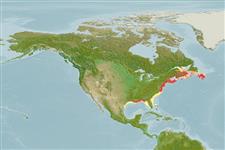Teleostei (teleosts) >
Eupercaria/misc (Various families in series Eupercaria) >
Moronidae (Temperate basses)
Etymology: saxatilis: saxatilis --- living among rocks (Ref. 1998).
More on author: Walbaum.
Environment: milieu / climate zone / depth range / distribution range
Ecology
Marine; freshwater; brackish; demersal; anadromous (Ref. 51243); depth range 30 - ? m (Ref. 2850). Temperate; 8°C - 25°C (Ref. 47172); 49°N - 27°N, 94°W - 59°W (Ref. 86798)
Western Atlantic: St. Lawrence River in Quebec, Canada to Lake Pontchartrain in Louisiana; south in Florida, USA to St. Johns and Suwannee river drainages.
Size / Weight / Age
Maturity: Lm ? range ? - ? cm
Max length : 200 cm TL male/unsexed; (Ref. 86798); common length : 120 cm TL male/unsexed; (Ref. 9988); max. published weight: 57.0 kg (Ref. 2850); max. reported age: 30 years (Ref. 1468)
Inhabit coastal waters and are commonly found in bays but may enter rivers in the spring to spawn (Ref. 2850). Some populations are landlocked (Ref. 7251). Voracious and opportunistic feeder (Ref. 5951). Larvae feed on zooplankton; juveniles take in small shrimps and other crustaceans, annelid worms, and insects (Ref. 1998, 10294); adults feed on a wide variety of fishes (alewives, herring, smelt, eels, flounders, mummichogs, rock gunnels, sand lance, silver hake and silversides (Ref. 5951)) and invertebrates (squid, crabs, sea worms and amphipods (Ref. 5951)), mainly crustaceans (Ref. 1998). Feeding ceases shortly before spawning (Ref. 1998). Utilized fresh and eaten broiled and baked (Ref. 9988).
Move into fresh or brackish water to spawn (Ref. 39467). Females spawn more than once in a season, but they don't necessarily spawn every year (Ref. 1998).
Heemstra, P.C., 1995. Moronidae. Lubinas. p. 1289-1292. In W. Fischer, F. Krupp, W. Schneider, C. Sommer, K.E. Carpenter and V. Niem (eds.) Guia FAO para Identification de Especies para lo Fines de la Pesca. Pacifico Centro-Oriental. 3 Vols. FAO, Rome. (Ref. 9320)
IUCN Red List Status (Ref. 130435: Version 2025-1)
Threat to humans
Harmless
Human uses
Fisheries: minor commercial; aquaculture: commercial; gamefish: yes
Tools
Special reports
Download XML
Internet sources
Estimates based on models
Preferred temperature (Ref.
123201): 1 - 23.5, mean 9.3 °C (based on 22 cells).
Phylogenetic diversity index (Ref.
82804): PD
50 = 0.5781 [Uniqueness, from 0.5 = low to 2.0 = high].
Bayesian length-weight: a=0.00933 (0.00745 - 0.01169), b=3.05 (2.98 - 3.12), in cm total length, based on LWR estimates for this species (Ref.
93245).
Trophic level (Ref.
69278): 4.7 ±0.2 se; based on diet studies.
Resilience (Ref.
120179): Low, minimum population doubling time 4.5 - 14 years (K=0.12; tm=5-7; tmax=30; Fec=14,000).
Prior r = 0.31, 95% CL = 0.20 - 0.46, Based on 2 full stock assessments.
Fishing Vulnerability (Ref.
59153): High vulnerability (61 of 100).
🛈
Climate Vulnerability (Ref.
125649): High vulnerability (61 of 100).
🛈
Nutrients (Ref.
124155): Calcium = 14.4 [7.1, 30.8] mg/100g; Iron = 0.291 [0.146, 0.542] mg/100g; Protein = 19.4 [18.5, 20.4] %; Omega3 = 0.583 [0.331, 1.065] g/100g; Selenium = 16.5 [7.6, 34.2] μg/100g; VitaminA = 8.61 [2.38, 30.88] μg/100g; Zinc = 0.307 [0.217, 0.451] mg/100g (wet weight); based on
nutrient studies.
